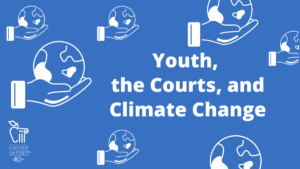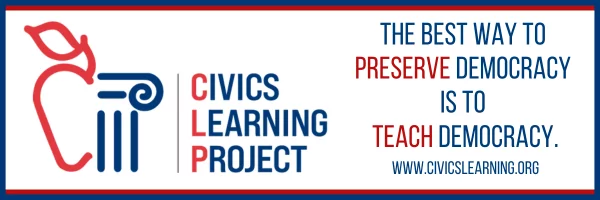 In recent years, young people are increasingly using the judicial system as a tool in their fight against climate change. This phenomenon reflects the growing recognition among young activists and climate advocacy groups that the judiciary can be a venue for addressing environmental issues, as other venues, especially within institutions of governance, have been less responsive. With climate anxiety and activism on the rise, in particular with school-aged youth globally, some young people are seeing success in advancing their agenda through the courts.
In recent years, young people are increasingly using the judicial system as a tool in their fight against climate change. This phenomenon reflects the growing recognition among young activists and climate advocacy groups that the judiciary can be a venue for addressing environmental issues, as other venues, especially within institutions of governance, have been less responsive. With climate anxiety and activism on the rise, in particular with school-aged youth globally, some young people are seeing success in advancing their agenda through the courts.
Environmental advocates for combatting climate change have tactically used judicial systems for decades. It was not until the 1990’s that youth-centered lawsuits became international headlines, specifically when 43 Filipino children brought an action against their Philippine Government for the misappropriation of their country’s forest resources. The Philippine Supreme Court upheld their standing and halted the deforestation.
In more recent history, a cornerstone climate case occurred when a group of young plaintiffs filed a lawsuit against the U.S. in 2015. The plaintiffs alleged the U.S. government was violating their constitutional rights to life, liberty, and property by encouraging and permitting the production of fossil fuels, as well as the violating the government’s sovereign duty to protect public. The case, Juliana v. United States, is still moving its way through the court system, and after many judicial actions, sees the plaintiffs preparing for trial at the U.S. District Court level. The Juliana case also helped motivate young people around the world to bring their own cases to various judiciaries. This includes cases brought by Portuguese youth, various Pacific Islanders, and young people from Hawaii.
By far the most notable case was recently decided within the Montana District Court. The case, Held v. Montana, filed in 2022, saw the plaintiffs sue the state of Montana for violating their state constitutional rights to a clean and healthful environment. The lawsuit argued that the state’s failure to adequately address climate change infringes upon the plaintiffs’ rights and future prospects. The court found that a provision of the Montana Environmental Policy Act prohibiting consideration of greenhouse gas emissions and corresponding climate change impacts violated the plaintiffs’ rights under the Montana Constitution. Held marks the first major victory youth climate activists have had in the courts. These cases, and more, demonstrate that young people worldwide are harnessing the power of the judicial system to address climate change, building on historical precedents and advocating for change at local, national, and global level. As youth continue to shape the discourse on climate justice, their efforts serve as a reminder of the power of young voices in driving positive environmental change.
This week’s Current Events resources examine young people’s utilization of various judicial systems in their efforts to combat climate change and the human activities causing it. The resources shared provide information and context around the lawsuits, both historical and ongoing, as well as the legal theories used by the plaintiffs.
Essential Questions, Vocabulary & Extend the Resources:
- What are constitutions designed to do?
- What are the differences between a state constitution and the U.S. Constitution?
- What is standing and how is it affecting youth’s climate change cases?
- Where do youth (people under the age of 18) fit into the U.S. judicial system?
- What are the major differences between the Juliana v. U.S case and the Held v. State of Montana case? How might those differences have influenced the cases’ different outcomes?
- In your opinion, is the judicial branch the best government branch for advocates to center their focus on when pressing for climate action within the U.S. government?
- In your opinion, has the work done within the United Nations going to positively affect youth’s prospects in their home country’s judicial systems?
Click here for a hardcopy of the Essential Questions and Youth, Climate Change, Courts Vocabulary
Click here for a hardcopy of Extension Activities CLP suggests implementing with this content
Videos:
Podcasts:
The kids suing their state for climate change, The Weeds, VOX, August 14, 2023
Bringing Climate Change Into the Courtroom, On the Media, September 22, 2023
An Update on the Big U.S. Youth Climate Lawsuit, Drilled, January 28, 2022
Held v. State of Montana, Hothouse Earth, Vermont Law & Graduate School
Background Resources:
Juliana v. U.S., Our Children’s Trust
The young people taking their countries to court over climate inaction, The Guardian, May 7, 2021
Young climate activists demand action and inspire hope, UNICEF
The Constitution of the State of Montana
Recent Articles:
Oregon lawsuit by youth over climate inaction not likely to be helped by judicial win in Montana, Oregon Capital Chronicle, September 11, 2023
This is about our human rights:” U.S. youths win landmark climate case, United Nations Human Rights, August 29, 2023
UN seeks to help children battling climate change in court, Reuters, August 28, 2023
Montana youth climate lawsuit could benefit federal case in Oregon, though not directly, OPB, August 20, 2023
Hawaii’s youth-led climate change lawsuit is going to trial next summer, Grist, August 7, 2023
Young people are using the courts to hold the US government accountable for the climate crisis, Prism, December 19, 2022
Kids Win Again In Lawsuit Blaming Gov’t For Not Fighting Global Warming, Forbes, May 1, 2016
Recent Editorials:
Opinion: A new tool in the fight to save the planet? A 6th-century Roman doctrine, Washington Post, September 1, 2023
Why the courts can be a powerful place for students to take action on climate change, Columbia Spectator, September 12, 2023.
Commentary: Sorry, kids. The courts won’t save the planet, Walla Walla Union Bulletin, August 19, 2023
Lesson Plans:
Should a clean and healthy environment be a constitutional right?, National Constitution Center Lesson, The Exchange
Human Rights and the Climate Crisis, Human Rights Watch
How to Teach Students About Climate Change—Without Giving Them Eco-Anxiety, Education Week, June 26, 2023
Young Activists in Montana Win Landmark Climate Change Lawsuit, PBS Learning Media
Resources for Younger Students:
The Right to a Clean Environment, Grades 3-5, The Advocates for Human Rights
A Guide to Climate Change for Kids, Grades 3-5, NASA
Third Grade, Advocacy, Discovering Justice
Where do We Fit In?, California Courts, The Judicial Branch of California


